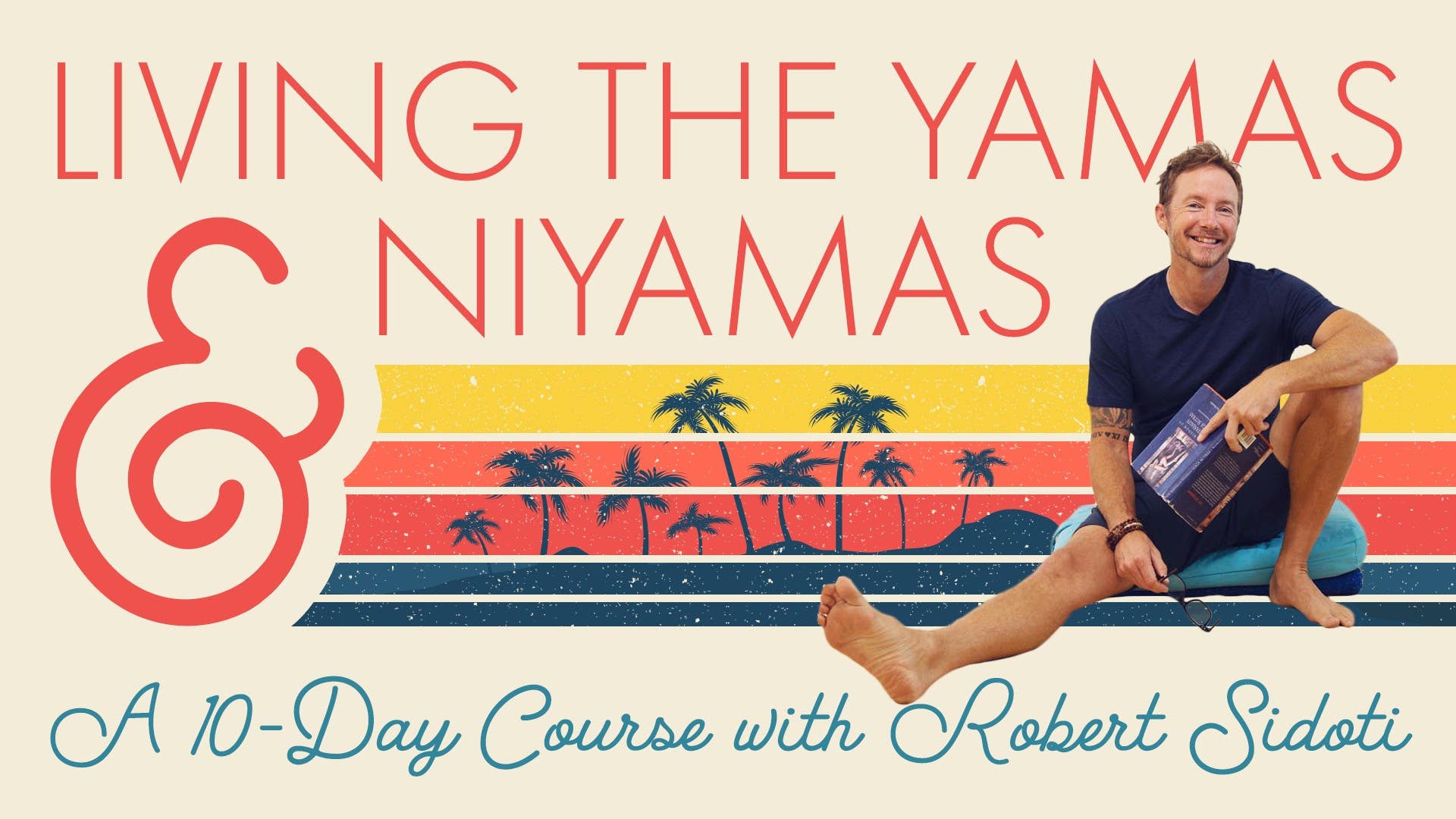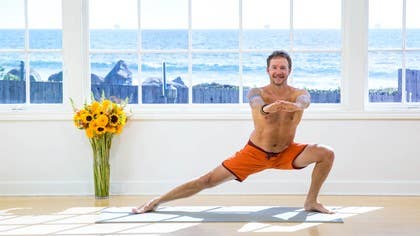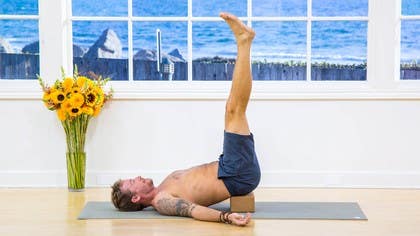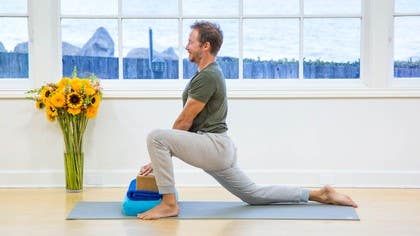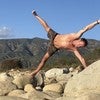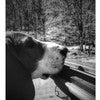Description
About This Video
Transcript
Read Full Transcript
Hey there, welcome back. Here we are again. This is number nine, Svadhyaya, Svadhyaya, Svadhyaya. How would you like to say it? That's how I say it, Svadhyaya, perfect.
What do you think? Okay. So this is about self study. The study of yourself, the study of myself, my body, study of my thoughts, study of my actions, right? So I view this as how can I consistently learn more about myself, right?
So that I can adjust behaviors, patterns that might not be serving me or the people around me, adjusting behaviors and patterns, learning skills, right, taking on new skills so that I can continue to grow and evolve. You know, I think the big one for me when I think of this niyama, remember niyama, miyama is about me, is I think of my thoughts, you know. I think of how powerful my own thoughts, your thoughts, all of our thoughts are and can be and how they can really affect your health. You know, I have very close people in my life who tend to have some, you know, a lot of negativity and this isn't a judgment thing. We have conversations, I have conversations with them all the time and we try to figure it out, but they have a lot of ailments due to the negativity in their daily life.
And so I'm always looking at and trying to figure out what types of thoughts are dominating my day and not only just for my health, but like for productivity and like what I want to do. At the end of the day, I really want to live as optimally as I possibly can, as healthy, as vibrant, as positive, I want to leave a lasting mark, I want to, you know, I want to do a lot. I also want to enjoy my life and be content as we have practiced, right? So all of these yamas and niyamas, right, we're coming toward, this is number nine. This is all kind of coming together and you can see how you can utilize a lot of them all in each and every one you can bring in the others.
So I won't go on a long, long, long discussion here, but how can you pause every once in a while, right? Maybe there's a morning meditation and evening meditation. It's that concept and practice of turning inward, looking inward, withdrawing from your senses. You'll see as you go through the eight limbs of practice, number five is pratyahara. That is all about, so we do that through meditation, through breathing.
It's another conversation, but that's what we're looking at here. We're looking at investigation and exploration of who we are and how we can either embrace what is amazing, shift what isn't great. Okay. Does that make sense? Are we on the same page?
All right. So this practice, I invite you to explore. We're going to move at a decent pace, meaning like slow enough for you to cruise around and check it out. All right. Watch your thoughts.
With all of that said, I hope that was somewhat engaging for you. Let's start in child's pose. Keep your, if you have block, keep it nearby. We will use it later, but not too much later. All right.
So one of my favorite postures, child's pose. So we're going to sit back into child's pose and stretch through the hips, stretch through the ribs, those intercostal muscles around the rib cage. If you feel it in your shoulders, you're going to feel this differently at different stages of the day. I'm not sure what stage of the day this is for you, but there's always a feeling in this pose. So let's pause here.
One. Oh, I was going to say one, but let's do two, let's do two breaths here before we begin any movement. So breathe in, breathe out. One more time. Breathe in and breathe out, stretch the arms forward, tabletop.
You've been here before and what's nice about this is what I invite you to do is, you know, some of the poses that you have some experience with and you're comfortable with, let the postures be almost secondary. What's the, the priority might be, what's the quality of my mind, you know, what am I thinking about? And maybe you can use this as a moving meditation more than anything. So from tabletop, let's move through cat cow, inhale, pull the shoulders back, arch the back, exhale, cat pose, round it out, pull the low belly up, up, up and in, spread the shoulder blades wide, inhale, move through cow pose, exhale, cat pose, inhale back to neutral and we're going to take this like puppy side stretch action. So walk the hands over to the left, keep the hips up over the knees, stack the right hand on top of the left and push your hips back.
More specifically, push your right hip back, maybe draw the right shoulder down and see what types of movements you can do to access a meaningful interesting stretch through the right side of the body. Okay, let's try the other side and notice one side might feel different than the other. Most likely it always does. Right hand below the left, push the left hip primarily back, so you're pushing it back like in the direction of child's pose, but you're staying more like located the hips up over the knees, puppy pose style. Come back out, let's actually drop into a puppy pose, walk the arms forward, hips up over the knees, chest, maybe the chin, I got a little itch on my calf, chest and chin toward the floor or the forehead, shoulders can get a little intense here, so adjust for that.
That adjustment would be bringing your arms back a little bit more, elbows and forearms down. Press into the hands, walk the hands back underneath, one more cat cow to kind of rinse it. Neutral, spread the fingers, curl the toes, downward dog. Let's take the right leg up, you can bring the left foot more left center of the mat, right leg lifts, if you have the ability and interest, bend it and then peel that right hip up and open so we can access more space through the right side of the body. Keep pushing the chest toward the back foot, maybe you roll deliberately through that right hip, investigating the hip, bring that down, arms might be fatiguing a little bit, normal.
Take a break if you need, left leg lifts, bend, open the hip, roll the ankle, roll that hip joint, nice, bring the left foot back down, take a moment to bring the knees down and if you've got those blocks nearby, go ahead and grab them and put them on either the low, I'm going to put them on the medium height, that's just my preference, you probably know that by now. So they're about shoulder width, something where your downward dog would be or your plank. Get a good hold on the blocks, make sure they're stable and we revisit downward dog. Take the right leg, lift it, you can just send it straight back, not opening the hip here. One time you're going to come into plank and bring the right knee to the elbow or higher, kind of engage the core, continue to optimize that core area and step the right foot out to the outside of the block and when you land it there, straighten and bend it a couple times and when you bend it you can drop the hips down and forward.
We did a similar movement, if not the same earlier on in the practice, meaning way back to number one or two, ahimsa, satya, don't forget about those guys. Back into the lunge, let's open up into a twist, rotate. So I was focusing a lot on the thoughts in the little discussion but you know, don't forget about the body, investigate the body, take good care of the body, get to know how your body functions. Back into downward dog, left leg lifts, breathe in, bring it to the elbow or higher, fire up that core a little bit and step the left foot out wide. Drop the hips, straighten the left leg a little bit or a lot and you can see how these blocks really assist in kind of getting deeper or accessing these two shapes.
This brings the ground up a little bit higher, so you're bending and straightening as I am. You know and the other thing with a lot of these practices that we're doing together is we're not looking to get wildly complicated, you know, that's not my intention, let's take the twist, we're looking to move the body in all these different ways that are really helpful and functional in walking down the street and doing the activities you enjoy doing, like moving, finding like fluidity and movement in the body to promote feeling good. Alright, now let's step the right foot out wide, squat for a moment and we take squat all the way to rise in mountain pose, inhale, exhale the palms right back to center and you can drop the arms for a moment, keep your feet out here, blocks where they are, we're going to use these for some squat salutations, okay? So we reset, self-study, breathe in, arms reach up, breathe out, squat pose, hands come to the blocks, step back into plank pose, optional push up, meet in downward dog, good, leg lifts on the breath in, right knee to right elbow, kind of grazes the elbow or the tricep and step, pause there, inhale, you can drop the hips a little bit, get that stretch and as you exhale, step the left foot forward into squat pose, drop, that's exhale, now inhale rise up, exhale back down into squat, inhale back into plank and lower, exhale downward dog, left leg rises on the breath in, knee toward that elbow or left upper arm, kind of grazes it, you feel the core light up, step, drop, finish the exhale, inhale, exhale right foot wide, squat pose, inhale rise all the way up, exhale, squat, try to keep good alignment in the spine, plank pose, this time see what it feels like to lower down and move through your upward dog like we did in santosha practice, downward facing dog, right leg lifts, breathe in, let's light up the core two times, so knee to the right arm, one, inhale it back, exhale two, step, finish the exhale, drop the hips, open the chest, breathe in, to exhale left foot wide, squat, inhale rise up, exhale squat, plank pose, halfway down, upward dog inhale, downward dog, exhale, find your rhythm and flow, left leg lifts, inhale, exhale knee to that left arm in a strong plank pose, inhale send it high, exhale knee to the arm, grazes it, steps, finish the exhale as you drop the hips, lift the chest, find that low lunge, exhale step wide, squat, inhale, exhale, plank pose, take these blocks a tiny bit wider like we did in that santosha practice, exhale lower halfway, inhale, peel it through, open up, upper body downward facing dog, exhale, one more on each side but this time we're going to light it up three times on that core, right leg lifts, breathe in, knee to elbow or higher, one time, inhale, exhale, remember push that ground away, spread the shoulder blades nice and wide, inhale, exhale, send it all the way up, finish the exhale by dropping the hips down, pulling the chest back like a or open like you would an upward dog, breathe in and exhale, step the left foot forward, squat pose, opening up the hips every single time, right reach up, inhale and last one on this left side, exhale lower, good form in the squat, step back into plank, lower down, inhale up, exhale down, left leg rises, breathe in, exhale three times now, knee to the arm, left arm, midline strong, exhale two, inhale, exhale three, step out wide, drop those hips open up, breathe in, exhale right foot wide, squat down, rise up, breathe in and exhale palms rest at the chest, we're going to do 10 squats, right, and so it's going to be a breath shift, we're not going to inhale up, we're exhaling up, okay, so from here what you do, we breathe in, lower down, try to keep that body upright, exhale inhale, we did this in tapas, the last practice, exhale strong arms, strong legs, strong core, exhale three, exhale four, find your range of motion, your depth right, five, even right here you can be, exhale pull those arms in right, you don't really have to bend too deep, I know a lot of us have some knee stuff going on, exhale six, exhale seven, exhale eight, exhale nine, and tree pose, move the blocks, I'll face you, say hi, okay tree pose on our right side, so hopefully we've kind of bolstered up our heart rate a little bit, we use this balancing pose to come on down, so bring the palms to the chest, ground the right foot, place the left heel right above the right ankle with your toes there, okay, this is really helpful kind of grounded tree pose, if you have problems or trouble balancing, you have those left toes to give you that stability, stand tall though trying not to kick into that right hip, take that right hip and pull it into the midline here, if you've got the balance and interest slide that left foot up to the calf right below the knee, left knee is open so you have this passive hip opener, okay, you take the arms up and choose whatever arm position you'd like, push the left foot into the right calf, right calf into the foot, so this kind of like pulls things to the midline back to the core and your glutes, and the wobble is really good, I find it to be kind of fun, it's a little bit of a challenge, it also fires up, lights up a lot of muscles in your feet and lower legs that we wear shoes, we sit a lot, those muscles kind of they get lazy, let's just leave it at that, okay, let's exit out of that, boom, good job, inhale the arms up and exhale palms to the chest, I set it up on the other side, new moment, totally new moment here, so bend the right leg, turn the knee open, heel above your left ankle this time, but again watch that left hip kicking out, pull that left hip right to this midline position, palms at the heart, stay here if you need those toes, there's nothing wrong with that by the way, if you have some steadiness and you want to play with it, bring that right foot to the calf, below the knee or above the knee, it's important, now push the foot into the calf or the leg, leg into the foot and get tall for a moment, can you get super tall, take the arms up, stretch it out, you know if you're having a tough time and you're coming in and out, this is one of those postures that could be helpful in watching your immediate reaction and internal kind of mindset, what does it trigger, right, because that might be an example of other things that you might fall short on, right, or it's a good self-study moment, all right, let's get on out of that, breathe in, arms up, breathe out, back to center, satisfied, sentosha, okay, now we're gonna do a little balancing series now, okay, with a lunge, one of my favorite little series, so let's see how it goes, so we come back to the front of the mat, we get back in the flow, right, we get back in the flow of awareness, subtle feelings and thoughts, we start now with balancing on our right leg, lift your left knee, that's the first movement, lift the left knee, engage the core, we've done these core movements before on our back and we don't wanna let those ribs pop out and arch, so low ribs, hug in, nice and braced, now with control, bend your right leg and step back into a lunge pose, take the arms up, we did this lunge step back in that tapas practice, okay, warrior three, palms to the chest, lean forward, lift the left foot and lean into that warrior three, this doesn't have to be fast or aggressive, this is slow, contemplative, kind of meditative movements, so try to find that even as I'm like, jammering on with cues and instruction, now from warrior three we flow up to that knee high position, bend the right leg and send that left ankle on top of your right thigh, little standing pigeon pose, just like so, or you can deepen it by bringing the arms forward, push the hips back to increase that stretch through the outer right hip, all the while balancing, it's also right hip and left, okay good, now back up, knee high, step back into your lunge, take the arms up overhead, big breath in and exhale, step back up to the front of the mat, sweep the arms up overhead, inhale and exhale, we're gonna do the same on the left leg now, so balancing on the left leg, lift your right knee, you can stay here the whole time, low ribs in, core activated, breath control, relaxation, step back into lunge, step back, take the arms high, breathe in, warrior three, palms rest at the chest, bend the right leg, upper body stays straight, slightly lifted in the chest like you would cobra, right leg is strong and steady, knee comes back up high like you're trying to reach the knee up to the ceiling, bend the left leg a little bit, take the right ankle on top of the left thigh, open the hip, stay right here or arms forward, push the hips back to increase the stretch in the outer right hip, glute, good, back up to center, nice right knee high, step back into lunge one more time, arms up and palms back to the chest, step up to the front of the mat, standing forward bend, take the arms up on the breath in, put a slight bend in the knees, pitch the hips forward, getting that stretch in the hamstrings and fold forward, not feeling like you need to straighten your legs, soft bend in the knees, come up into a flat back with your knees bent, we're going to hold this for about 10 breaths let's say, inhale, lengthen out, push those hips back, knees bent and fold your belly, your chest over your thighs or on the inside of the thighs, relax the back of your neck and head, option one, hold on to opposite elbows, option two, reach back behind your calves and clasp your fingers or hold on to a wrist, option three, take your hands, walk them underneath your toes toward the arch of each foot, stepping your toes on your wrist, this is kind of a nice wrist stretch as well, as well as forearm, shoulders upper back, find your position, find your breath, let's take one more breath here, exhale everything out, undo the hands wherever they are, half lift, just to get a little adjustment, some length and extension of the spine and one more fold, walk the feet out wide, squat pose, we've been here before, might feel like a little relief, you can round up the back a little bit or extend the spine and bring it on down to your seat, okay, seated windshield wipers, okay, this is our twist for the practice, so arms are going to come back behind you, feet are nice and wide and we take this movement, left leg over to the left, right leg to the left and you peel the opposing right shoulder open, good and now you come up to center, legs over to the right, left shoulder back and one more time on each side, to the left and to the right, back up to center, okay, now grab your block, we are going to, just as we did in santosha practice, we're going to place a block underneath the low back for that supported shoulder stand or supported bridge pose, so supported bridge pose would be block below the low back, legs out wide with the knees drawn toward one another, feet together, knees out wide or feet right below the knees neutral, second option would be legs up and kind of tilted back just enough so that they're not hovering out in the space where it feels like you've got to work to hold them up, so find a good position for that block where it's not driving into your back too much, it gives the support needed to rest the legs up over the hips, relax your arms and now is the point in the practice where we really slow it down and kind of withdraw from the outside a little bit from our physical senses, our bodies, the sensations and feelings in the body and more like tune into breathing, the thoughts coming in and coming out through your mind and it's not like you're trying to do anything with anything, in my practice of this it's I've got the shape, I focus on my breathing and I watch and kind of just witness without trying to control anything the tendencies of my mind. Feel my heartbeat, breath coming in and out, so what we're looking at with this practice is an intimacy, it's a real intimate relationship with yourself and in my experience being in relationship with something or someone that requires communication and listening and maybe you know listening without having to fix or control just to be there to witness and listen.
Where can we find more opportunities in our daily life, our busy daily lives to sit, to sit with ourselves and what I've learned over time with myself is I've learned that I like who I am and I like spending time with myself, like I'm comfortable, I look forward to that time. You can stay here with the legs up or you can bring the feet down and maybe explore that supported bridge for a few moments. I believe it was our first practice together, the quote and I said to my body softly I want to be your friend, took a long breath and replied I've been waiting for this my whole life, I think of that with this type of practice, you can stay here longer if you'd like and we are going to as an option make our way up to sit and take a little meditation together and use your block and sit on a blanket. Make yourself comfortable, as comfortable as you can, knees are comfortable, hips are comfortable, your breath is comfortable, you're sitting upright but it doesn't have to be perfect. Find the alignment that allows you to sit comfortably with yourself in a seated meditation and this meditation it isn't about getting anywhere or doing anything in particular, it's simply about being in the present moment with the existing thought, with the existing breath, the existing sensation in the body and just kind of moving from moment to moment, breath to breath without holding on parigraha, right, clasping to any one feeling or sensation or thought.
First it might be very helpful to draw all of your attention to the breath, so you tether your entire focal point or attention to the inhalation and exhalation. Exhale I'm breathing in, exhale I'm breathing out, inhale I am breathing in, exhale I'm breathing out, inhale I am breathing in, exhale I am breathing out, inhale I am breathing out, soften the facial muscles, try to relax your shoulders or any other body part that tenses up when you sit still. The practice of staying, staying, don't leave, stay present, move from one, one breath or one moment to the next, softening, letting go. It is a very difficult thing to do, to sit still with your thoughts, so don't be hard on yourself. What's beautiful about it is that when you start to get hard on yourself or you start to get a little lost or distracted or holding on or agitated or frustrated, you can always stop, take a breath, exhale it all out and reset, start again.
So I invite you to sit, stay with that seated meditation as long as you'd like, if you find a groove and you're in a bit of a flow and you like the feeling, stay with it. I'm going to move down into a relaxation, so we'll take a few minutes of relaxation together or seated. The relaxation could be supported bridge, supported shoulder stand, seated meditation or grounded, lying on your back, just the evening you can lie in your bed and fade off into sleep. Whatever pose or posture or shape you've chosen, can you find a space, a feeling of satisfaction and contentment? Okay.
All muscular effort in the body dissolves with every long extended calming exhalation. A few deep breaths and start to move your body in natural ways. Ways that you don't even think about. It feels natural to come out of a rested space and place. Stretching and moving.
Maybe even take your right hand all the way to your left shoulder, left hand to the right shoulder. And notice, right, you've got yourself in this nice big hug. You can use this little moment here, this hug, as a commitment that you'll continue to study. Study yourself. Be in beautiful intimate relationship with you.
Come up to sit. I could have definitely laid down there for a while. I'm happy to be here now sitting with you, closing out. Svadhyaya. Self study.
I hope that was helpful for you in some way. One word or all of it, I don't know. But. Thanks. Thanks for being here.
Namaste.
Living the Yamas and Niyamas
Comments
You need to be a subscriber to post a comment.
Please Log In or Create an Account to start your free trial.

